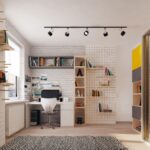Interior design has evolved significantly, offering homeowners and businesses multiple ways to transform their spaces. With the rise of digital solutions, online interior design services have gained popularity, providing a convenient alternative to traditional in-person consultations. If you’re considering a design project, it’s essential to understand the differences between these two approaches to determine the best fit for your needs.
Online Interior Design Services
Online interior design services provide a digital approach to decorating and furnishing spaces. These services typically involve virtual consultations, 3D renderings, and digital mood boards to help clients visualize their designs before making purchases.
Benefits of Online Interior Design
- Convenience: Everything is done remotely, eliminating the need for in-person meetings.
- Cost-Effective: Online services often have lower fees compared to traditional designers.
- Flexibility: Clients can collaborate with designers from anywhere, regardless of location.
- Fast Turnaround: Many online platforms provide design plans within days or weeks.
- Access to Digital Tools: Clients receive 3D models and virtual room layouts for better visualization.

Limitations of Online Interior Design
- Lack of Physical Interaction: Online designers rely on digital images and may not fully grasp the texture, lighting, or spatial feel of a room.
- Limited Customization: Pre-set design templates may restrict creativity for highly personalized projects.
- Self-Execution Required: Clients often handle measurements, purchases, and installations themselves.
Traditional Interior Design Services
Traditional interior design services involve face-to-face interactions with designers who oversee the entire process, from concept to execution. This hands-on approach ensures tailored solutions and high-quality results.
Benefits of Traditional Interior Design
- Personalized Service: Designers visit the space, assess its dimensions, and provide customized solutions.
- Material & Texture Selection: Clients can physically see and feel materials before finalizing choices.
- Professional Project Management: Designers handle sourcing, ordering, and overseeing installations.
- In-Depth Consultation: More opportunities for communication and adjustments throughout the project.
- Higher-End Customization: Ideal for luxury or highly detailed design projects.
Limitations of Traditional Interior Design

- Higher Costs: Fees for in-person services, travel, and project management are usually higher.
- Longer Timelines: Custom design work and ordering materials can extend project durations.
- Limited Availability: Finding a designer within your budget and location can be challenging.
Which Option is Right for You?
Choosing between online and traditional interior design depends on your specific needs, budget, and project complexity.
- If you need a quick, affordable, and convenient design solution, online interior design services are ideal.
- If you prefer hands-on support, high customization, and expert project management, traditional interior design is the better choice.
Both options have their advantages, and in some cases, a hybrid approach—starting with online consultations and transitioning to in-person execution—can offer the best of both worlds. Ultimately, the right choice depends on your vision, expectations, and available resources.
Conclusion
Interior design is no longer limited to in-person consultations, as online services provide an efficient alternative. Understanding the pros and cons of each method allows you to make an informed decision that aligns with your goals. Whether you choose digital convenience or traditional craftsmanship, the key is to select a service that brings your dream space to life.
Also Read : Budget-Friendly Home Design Ideas to Upgrade Your Interiors





